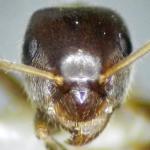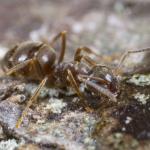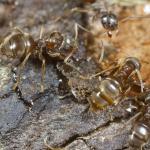Lasius platythorax is a small brown to dark brownish black ant which until recently was confused with L. niger (L). Seifert (1991) showed that it was a distinct species based on morphological differences coupled with distinctly different habitat preferences and and this is now accepted by most authorities. The scapes and tibia have erect hairs. The clypeus has sparse pubescence and the hairs on the pronotum are longer than those of L. niger.
It seems to be widely distributed in Britain and Ireland, but previous confusion with L. niger means that it is under recorded at this time.
Records are restricted to Europe and range from Norway to Corsican mountains.
No status is available as it was only recognised subsequent to the publications of Shirt (1987) and Falk (1991). Current data suggests that this species should not be regarded as scarce or threatened.
Lasius platythorax worker full-face view showing sparse pubesence on clypeus.
Compare with head of Lasius niger
Photo by Mike Fox
Found in cooler damper locations compared to its sibling species L. niger. Damp heaths, and woodlands are typical habitats. Unlike L. niger it seems to avoid human habitation and is not usually found in parks or gardens. No preference for soil type is apparent.
Seifert (2007) reports that the nuptial swarms take place on hot days some 230-130 mins before sunset during July and August. I know of no reports of nuptial flights in Britain and anyone living close to colonies could add to our knowledge by making observations. Whether these flights coincide or not with L. niger flights would be interesting to know.
Builds its nests in organic substrates, especially dead wood, with partly rotted tree stumps often being utilised. Nests can also be found in peat, leaf litter and grass tussocks but only rarely in soil. Colonies have a single queen and up to thousands of workers.
Little has been reported on foraging behavior. It is an aggressive species and bites readily.
2010




